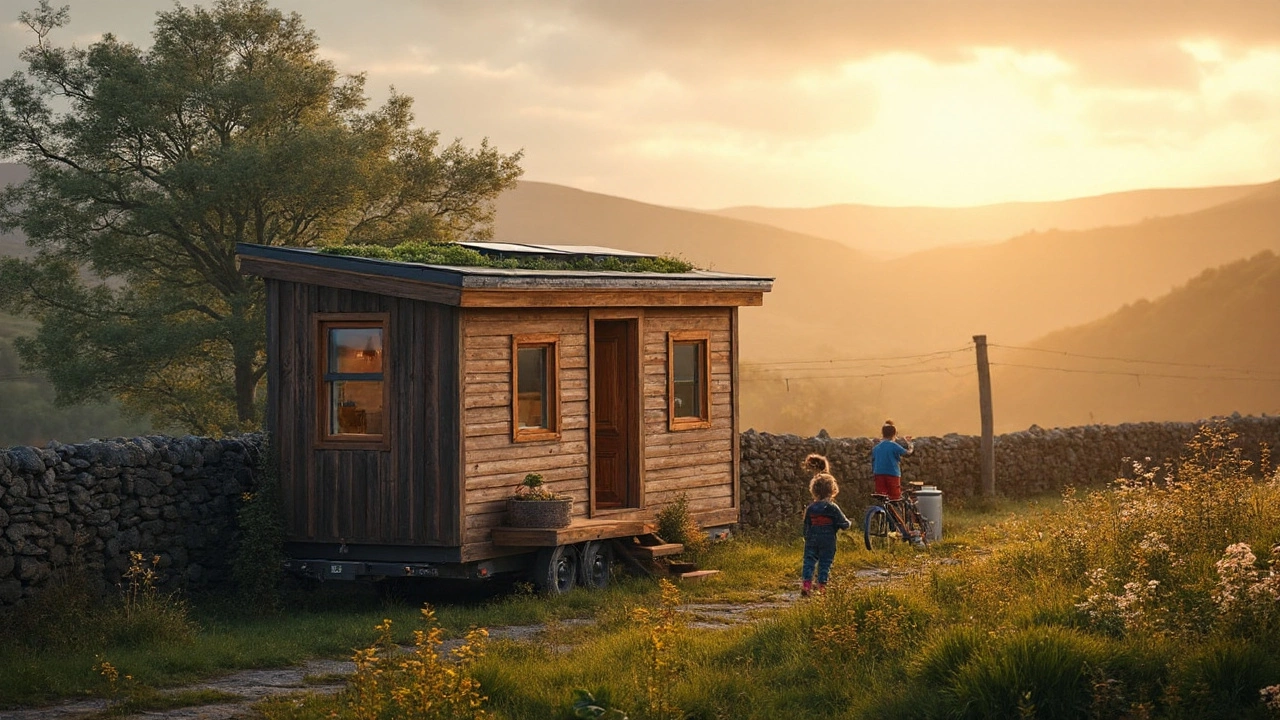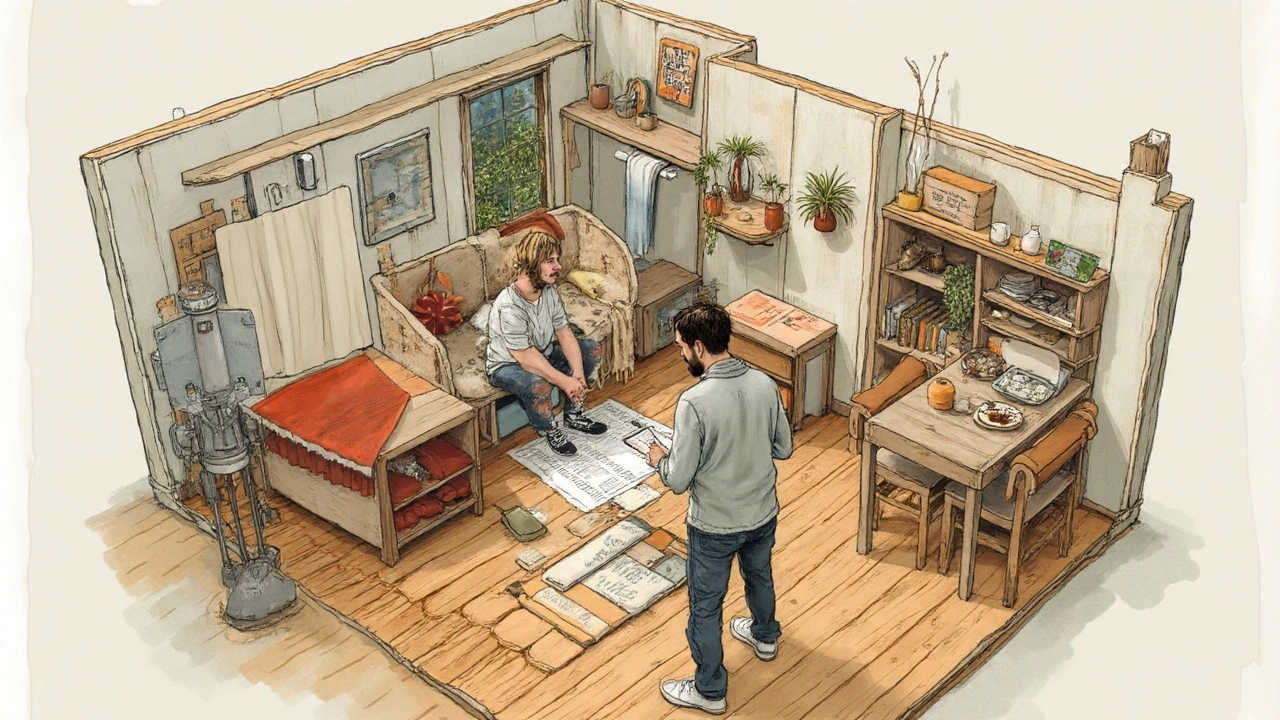How Tiny Houses Are Eco‑Friendly: Energy, Materials, and Real Numbers (2025)
 Sep, 16 2025
Sep, 16 2025
Want the truth in plain English? Tiny houses help the planet because they slash the big stuff that drives emissions: energy use, building materials, water, and waste. They’re not magic, and they’re not perfect. The eco benefits come from size first, then from smart design choices. If you treat a tiny home like a small version of a leaky, high‑carbon house, you’ll miss most of the gains. If you pair small with efficient, the footprint drops fast.
I live in Wellington, where the wind reminds you daily that insulation and air‑tightness matter. The same rules apply anywhere: less floor area means less to heat, cool, and build-then the details decide how far you go.
TL;DR: Why Tiny Houses Are Eco‑Friendly
Here’s the simple answer: at their core, tiny houses eco-friendly design works because you’re using fewer resources to meet the same needs. The big wins:
- Smaller space = less energy for heating, cooling, lighting, and hot water.
- Fewer materials = lower embodied carbon from manufacturing and transport.
- Compact systems = right‑sized appliances, often electric and efficient.
- Simpler living = less stuff, less water, less waste-by design.
But size isn’t the only variable. A poorly insulated tiny home can still waste energy. A heavy, steel‑intensive build towed long distances can burn a lot of fuel. The eco edge comes from tight building envelopes, low‑carbon materials, efficient electric gear, and sensible siting.
What you likely want to get done after clicking this:
- Understand exactly how tiny houses cut emissions and waste.
- Know the design moves that matter most (and which don’t).
- See real numbers to sanity‑check claims.
- Get a practical checklist you can actually use to plan or assess a build.
- Clear answers to common questions about off‑grid systems, toilets, and legality.
Step‑by‑Step: How to Design a Low‑Impact Tiny Home
The sequence matters. Do the low‑effort, high‑impact steps first.
Right‑size the space. Start with function: sleeping, cooking, bathing, work. Sketch zones, not rooms. A 20-30 m² footprint fits one to two adults comfortably. The smaller you go, the more multi‑use you need (fold‑down tables, lofts with safe stairs, drawers in risers). Every square metre you don’t build saves materials and lifetime energy.
Seal the envelope. Prioritise insulation, air‑tightness, and thermal bridges. Aim for at least NZ H1 levels or better (Wellington needs higher R‑values than Northland). Continuous insulation, taped sheathing or membrane, and thermally broken window frames are worth it. A heat‑recovery ventilator (a small through‑wall unit or compact MVHR) keeps fresh air without dumping heat.
Go electric-and efficient. Choose an inverter heat pump sized for a single, open space. Pick an induction hob, a small efficient fridge (200-300 L), and an Energy Star washer. For hot water: heat pump water heater if you have space; otherwise, a high‑efficiency electric cylinder with smart control or a right‑sized instantaneous unit. Electric beats gas when your grid is decarbonising (NZ electricity has a high renewable share).
Choose low‑carbon materials. Timber framing and cladding, cellulose or sheep’s wool insulation, plywood or FSC‑certified panels, linoleum or timber floors. Avoid over‑spec steel and concrete where you can; use them only where structure demands. Ask suppliers for Environmental Product Declarations (EPDs). Design for disassembly: screws over glue, modular panels, exposed fixings.
Water, wastewater, and ventilation. Fit low‑flow tapware (5-6 L/min) and 3-4 L dual‑flush or a certified composting toilet if legal in your area. Consider a shower heat‑recovery drain (simple vertical unit) to cut hot water demand. Use a small HRV or dehumidifier in damp climates to avoid moisture issues in tight envelopes.
Power strategy: grid, off‑grid, or hybrid. Grid‑tied is usually the lowest‑carbon when the grid is relatively clean and you don’t oversize systems. Off‑grid only makes sense if you size PV and batteries for winter, place panels well, and manage loads. A hybrid (small PV + grid) is often the sweet spot: resilience without a huge battery footprint.
Site sensibly. Aim for sun in winter, shade in summer. Plant native windbreaks where needed. Avoid earthworks that disturb soil carbon. Keep transport impacts low by minimising towing and choosing local materials. If parking in rural areas, check council rules for onsite wastewater, setbacks, and occupancy.
Quick decision mini‑trees you can copy:
- Heating: If winter lows regularly drop below 5°C → heat pump. If mild and sunny → passive design + small heat pump or radiant panel.
- Power: If you can connect to a clean grid → grid‑tied + small PV. If remote with shade → skip off‑grid; focus on efficiency first.
- Toilet: If council allows composting and you can manage it → certified composting unit. If not → low‑flush + septic or reticulated sewer.
- Structure: If you plan to move often → lightweight timber, maximise insulation. If permanent → consider slab‑less pier foundations to cut concrete.

Examples, Data, and NZ Context
Let’s pin this to real numbers. Ranges vary by climate, occupancy, and behaviour. The point is the scale of change, not a single perfect value.
| Item | Tiny House (20-30 m²) | Typical NZ Home (140-180 m²) | Notes / Sources |
|---|---|---|---|
| Annual electricity use | 1,500-3,000 kWh | 7,000-9,000 kWh | MBIE Energy End Use Database; regional averages differ; efficient tiny homes trend lower. |
| Embodied carbon (structure + envelope) | 5-15 tCO₂e | 60-100 tCO₂e | BRANZ CO₂NSTRUCT, MBIE Building for Climate Change guidance; material choices swing results. |
| Construction materials (mass) | 5-15 tonnes | 40-80 tonnes | Scaling from floor area; timber vs steel/concrete changes totals. |
| Indoor water use per person | 60-100 L/day | 140-180 L/day | Water NZ benchmarks; low‑flow fixtures and behaviour drive tiny‑home results. |
| Construction waste | 0.5-2 m³ | 5-15 m³ | Scaled estimates; NZ Ministry for the Environment notes C&D waste is a major landfill fraction. |
New Zealand’s grid sits high on renewables (hydro, wind, geothermal). That means electrifying heat and hot water in a tiny house pays off. In a high‑renewables grid, a 2,000 kWh/year tiny home emits a fraction of the CO₂ of a gas‑heated dwelling of any size.
“Energy efficiency is the ‘first fuel’ because reducing energy use is the cleanest and often the cheapest way to meet our needs.” - International Energy Agency, Energy Efficiency 2024
Two real‑world patterns I see in windy Wellington:
- Well‑sealed tiny homes rarely need much heating. A 2.5 kW heat pump often idles. The tough part is moisture: cook with lids, use extractor fans ducted outside, and run balanced ventilation in winter.
- Solar works, but roof area is limited. A 20 m² roof might take 2-3 kW of PV depending on pitch and shading. That’s great for shoulder seasons; batteries need careful sizing for winter. Many people go hybrid: PV for daytime loads, grid at night.
About embodied carbon: material swaps matter. Timber structure, cellulose insulation, and fibre‑cement or timber cladding perform well. Steel trailers add emissions; you can minimise thickness and avoid over‑engineering if the unit won’t be towed often. Permanent foundations? Consider timber piles or ground screws to cut concrete.
On waste: the Ministry for the Environment reports construction and demolition waste is a large share of landfill inputs. Small builds mean fewer offcuts and simpler deconstruction later. Designing modules to standard sheet sizes (e.g., 1200 × 2400 mm) cuts waste further.
Trade‑offs you should keep in mind:
- Mobility vs. performance: Wheels limit weight and thickness of insulation. If you won’t move, build like a small house, not an RV.
- Off‑grid vs. carbon: Off‑grid can mean extra batteries and a generator in winter. If your grid is clean, a small grid‑tied setup may be greener.
- Cost vs. carbon: Triple‑glazed windows are lovely, but the jump from good double‑glazed low‑E to triple may not pencil out in a tiny envelope. Spend first on air‑tightness and insulation continuity.
Checklists, Heuristics, and Pitfalls
Use these as your quick‑win toolkit.
Eco design checklist (copy/paste):
- Space plan fits actual life: sleep, cook, bathe, work, store without overflow.
- Continuous insulation around the whole shell; no obvious thermal bridges.
- Air‑tightness membrane or taped sheathing; blower‑door test if possible.
- Windows: low‑E double glazing minimum; external shading on west/north in summer.
- Ventilation: kitchen and bath exhaust to outside; consider small HRV/MVHR.
- Heating: inverter heat pump sized to load; ceiling fan for stratification.
- Hot water: heat pump water heater or well‑controlled electric; short pipe runs; shower drain heat recovery if showers are daily.
- Appliances: induction hob, efficient fridge, LED lighting, smart plugs.
- Water: low‑flow taps/shower, dual‑flush toilet or certified composting unit if legal; rainwater where allowed; sediment + carbon filters.
- Materials: timber dominant, EPDs where possible, low‑VOC finishes, screw‑first assembly for future disassembly.
- Site: winter sun, summer shade, minimal earthworks, permeable paths, native planting.
- Waste: design to standard sheet sizes; separate offcuts; plan deconstruction.
Rules of thumb:
- Every 10 m² you trim saves roughly 500-1,000 kWh/year in heating/cooling in temperate climates, assuming average practice.
- Heat loss scales with surface area. Compact shapes (fewer bumps and pop‑outs) perform best.
- In NZ’s climate, a tight, insulated 25 m² tiny home often needs a heat pump under 2.5 kW. Bigger units short‑cycle and waste energy.
- PV sizing: in temperate NZ, 1 kW of roof PV yields roughly 1,200-1,400 kWh/year if well oriented. Don’t rely on that mid‑winter.
- Water: drop to a 6 L/min shower and you cut hot water energy by ~40% compared to older 10 L/min heads.
Common pitfalls (and fixes):
- Condensation on cold mornings: That’s air‑leak + poor ventilation. Fix with air‑sealing, a continuous vapour‑control layer where needed, and balanced ventilation.
- Overheating in summer: Small volumes heat fast. Add external shading, cross‑ventilation, light‑coloured roofing, and a small awning over north‑ and west‑facing glass.
- Heavy trailer, heavy emissions: If you won’t move it, consider fixed foundations. If you will, keep the structure light and tow infrequently.
- Greenwashed materials: Ask for EPDs or at least credible certifications (FSC, low‑VOC). If data isn’t available, default to timber and mineral‑based finishes.
- Off‑grid oversell: Big batteries, big price, same sun. Start with efficiency; then size storage to your deepest winter week.
- Illegal wastewater setups: Councils differ. In NZ, check Building Code and local bylaws before installing composting toilets or greywater systems.

FAQ + Next Steps
Do tiny houses always use less energy?
Almost always, because there’s less to heat and light. But a leaky tiny home can still waste power. Insulation, air‑tightness, and efficient hot water make the biggest difference.
What about the carbon from towing?
If you tow once or twice, the extra emissions are small compared to decades of operation. If you tow frequently with a heavy ute, it adds up fast. Keep moves rare, keep weight down.
Is off‑grid actually greener?
Sometimes. In places with fossil‑heavy grids, a well‑designed off‑grid system may cut emissions. In NZ, where electricity is largely renewable, being grid‑tied with a modest PV array is often the lowest‑carbon choice.
Are composting toilets safe and legal?
They can be, if certified and managed well. Rules vary by council. You’ll need a plan for compost maturation and disposal. If rules don’t allow it, use a high‑efficiency flush connected to approved wastewater systems.
What’s the best insulation for a tiny house?
Any that delivers high R‑value with a good air‑tight layer. Cellulose, wool, or high‑performance foams can work; the key is continuous coverage and careful detailing around windows, corners, and junctions.
Does a tiny house help with water scarcity?
Yes. Small hot water systems, low‑flow fixtures, and shorter plumbing runs cut water and energy. Rainwater harvesting (where legal) plus simple filtration works well for laundry and garden use.
How do I check a builder’s eco claims?
Ask for R‑values, air‑tightness details, window specs, appliance efficiency ratings, and a materials list with EPDs. Request an estimated operational energy figure and the assumptions behind it.
What authoritative sources back this up?
Look to MBIE (NZ) for energy efficiency guidance, BRANZ for embodied carbon data, the IEA for energy efficiency trends, the IPCC for building sector pathways, and Water NZ for consumption benchmarks. These bodies gather primary data and publish it.
Next steps by scenario
- Designing now: Lock in your layout. Price triple options-more insulation vs. fancier windows vs. heat‑recovery ventilation-and pick the combo with lowest energy per dollar spent. Book a blower‑door test if possible.
- Buying a ready‑made model: Ask for a spec sheet with wall/roof R‑values, window U‑values, heat pump model, hot water type, and appliance ratings. If the seller can’t provide them, that’s a red flag.
- Upgrading an existing tiny home: Start with sealing (gaskets, tapes, door sweeps), then add external shading and a smart plug‑in hot water controller. Swap to an induction countertop hob and a heat‑pump dryer or drying rack.
- Going off‑grid: Audit loads (kWh/day in summer and winter). Size PV for winter sun, then battery for at least one cloudy day. Keep a backup plan (grid, generator, or flexible loads like laundry on sunny days).
- On a rural site: Map sun/wind, check council rules for wastewater and tiny‑home occupancy, and position for winter sun with summer shade trees you’ll actually maintain.
If you remember just one thing, make it this: small helps, but tight and efficient unlocks the real gains. Build (or buy) the tiny home that wastes nothing-space, energy, or materials-and the planet will notice.
Sources referenced: International Energy Agency (Energy Efficiency 2024); Intergovernmental Panel on Climate Change (AR6 buildings summaries); MBIE NZ (H1 energy efficiency, Energy End Use Database); BRANZ CO₂NSTRUCT; Ministry for the Environment NZ (construction and demolition waste); Water New Zealand (water use benchmarks).